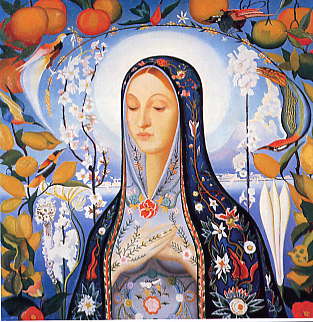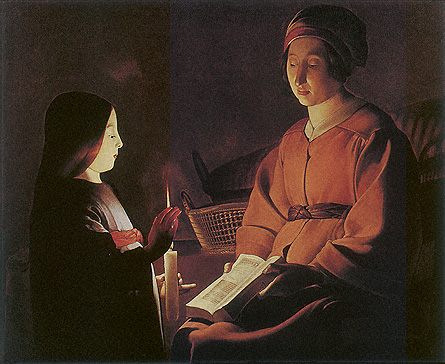VirginWith her title “Holy Virgin,” Mary joined the ranks of many other Goddesses with the same title: Athena, Asherah, Astarte, Aphrodite, Venus, Anat, Ishtar, Diana, and others. Clearly, since many of these Goddesses are also “Love Goddesses,” the ancient meaning of the word “virgin” differs from our modern conception. “Virgin” indicated an independent autonomous woman, a woman not required to answer to any man or child. The title had little to do with abstinence from sexual intercourse (A, B, *). In Christianity, much emphasis has been placed on Mary’s physical virginity and on the virgin birth of Christ. This section will explore the origins and implications of Virginity and Virgin Birth. The Virgin Birth as Symbolic
Joseph Campbell sees the virgin birth as symbolic, calling it “the birth of spiritual [hu]man out of animal [hu]man,” and “the birth of compassion.” He links the birth of Christ to the birth of Buddha, who was said to have The Gnostics (a sect of early Christians, authors of “secret gospels”) also saw the virgin birth as symbolic, a union of the female Holy Ghost, Sophia, with the male Father God. They rejected the notion of a literal virgin birth (D, p. xv, 53).
Why is a literal virgin birth so important to Christians? Nearly all Christians hold it as a main tenet of the faith because it confirms that Christ was fully human, yet fully divine. Virgin birth has held different and similar significances throughout history.
All of the virgin births discussed so far are God-begotten births. Another Of course, literal virgin births are quite common today with modern scientific
This may seem shocking at first, but perhaps not quite so shocking when we realize that we are back to the ancient definition: Virgin indicated an independent autonomous woman, a woman not required to answer to any man or child, a woman free to take lovers as she so chose (A, B, *). So many of us have been taught to view sex as such a sinful, negative, violent or lustful act that it is difficult to get our minds around the concept of sacred sex. Yet sex was sacred in ancient times. “The function of such ‘holy virgins’ was to dispense the Mother’s grace through sexual worship; to heal; to prophesy; to perform sacred dances; to wail for the dead; and to become the Brides of God” (A. p. 1049).
Kinstler has written a seamless fictional account of the story of Mary and Christ along these lines, based on scholarly evidence (E). In lore and art that has survived through the centuries, The Goddess is usually portrayed as a trinity (the original trinity!) of Virgin, Mother, Crone. Often “Maiden” will be substituted for “Virgin” to de-sexualize the word. Each phase of the Goddess represents the a phase in ordinary The Virgin or Maiden phase is marked at the onset of menstruation, the transformation of a child into a young woman. In this phase we celebrate the freedom of youth, expressed so eloquently in this dramatic poem by Wilshire: Spring’s daughter,
Not belonging to mother, not to father, not to lover, The Virgin belongs to Herself alone! Youth exultant Exulting in Her first bleeding Exulting in Her connection to the earth Exulting that She cycles with the moon Exulting in Her magically transforming body She–the sliver of New Moon barely becoming Hebe–the Virgin Moon! In this temple, we celebrate spring and all new beginnings, starting over, renewing ourselves. In this temple, we celebrate gifts that come unbidden, being full of possibility, pregnant with potential. This temple of becoming! (F, p. 149 – 52) |

|
Perhaps in honoring Mary as Virgin and in contemplating Virgin Birth, we are honoring our own purity and wholeness, youthful innocence, and new beginnings. Perhaps we have a sense of being washed clean, of starting over, of a spiritual rebirth, of a new-found freedom, no matter what our age, gender or experience. Can we reclaim this seeking, this fulfillment outside the bounds of sexual chastity? This is a question for personal contemplation. |
References
(A)
The Woman’s Encyclopedia of Myths and Secrets
By Barbara Walker
(B)
Alone of All Her Sex: The Myth and Cult of the Virgin Mary
By Marina Warner
(C)
The Power of Myth
By Joesph Campbell with Bill Moyers
(D)
The Gnostic Gospels
By Elaine Pagels
(E)
The Moon Under Her Feet: The Story of Mari Magdalene in the Service
of the Great Mother
By Clysta Kinstler
(F)
Virgin, Mother, Crone: Myths and Mysteries of the Triple Goddess
By Donna Wilshire
( * ) And numerous other sources





